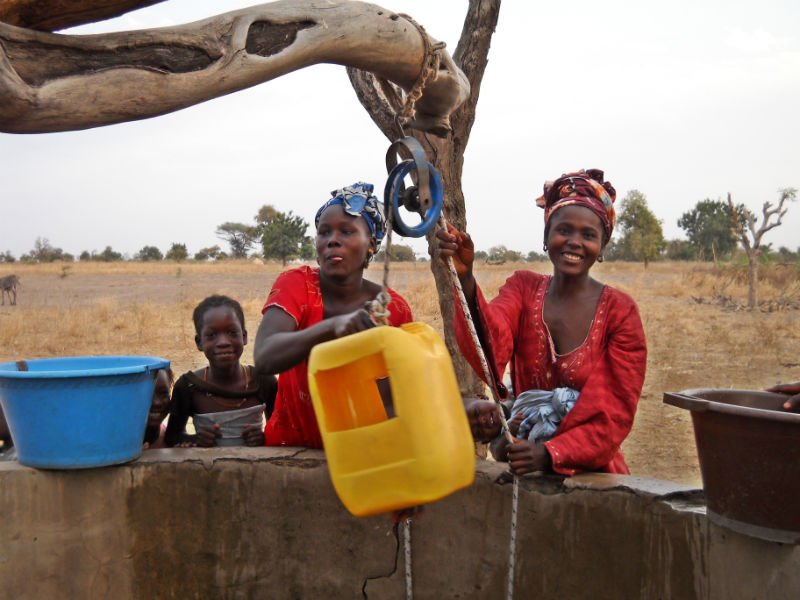Difference between revisions of "绳子与水桶"
| Line 34: | Line 34: | ||
====维护==== | ====维护==== | ||
| − | + | Woven nylon ropes may last for two years, but twined nylon or sisal ropes last only a few months. A good-quality hose may last for over two years, and most buckets last a year (depending on the material and quality). When people use their own rope and bucket, no extra organization is required. For community wells, a community committee usually organizes the maintenance and cleaning of the well, maintenance of the windlass, etc. Most repairs can be paid with ad hoc fund-raising.水桶的升降由放绳和拉绳,或旋转绞盘来控制。一定要小心防止绳子或水桶受到污染。预防性的维护包括给绞盘或滑轮的轴承上油。小型维修仅限于修补水桶和软管上的洞眼、重连水桶上的铰链及修复绞盘的轴承或把手。所有的小型维修可由当地人完成,工具和材料可从社区或本地区就地取材。大型维修、置换主要包括更换水桶、软管、绳子及部分或整体的绞盘。编织尼龙绳可用两年,但 | |
| − | |||
Brikke和Bredero在其著作''[http://www.who.int/water_sanitation_health/hygiene/om/linkingintro.pdf 社区供水与公共卫生中的技术选择与运行维护:规划师与项目工作者参考资料]'' 中,推荐下列图表中的运行与维护工作: | Brikke和Bredero在其著作''[http://www.who.int/water_sanitation_health/hygiene/om/linkingintro.pdf 社区供水与公共卫生中的技术选择与运行维护:规划师与项目工作者参考资料]'' 中,推荐下列图表中的运行与维护工作: | ||
Revision as of 08:28, 25 October 2015

这一装置主要与手工挖掘井工具一同使用。将桶系在绳子上降到水中。当桶碰到水的时候会下沉并装满水,再用绳子把它拉上来。绳子可以由手拉动,运用滑轮或绕在绞盘上。有时,畜力牵拉可与滑轮一同使用。改良的装置会将绳子绕过滑轮,再用两只水桶——绳子两端各系一只水桶。对于浅于10米深的水而言,可以使用带有软管的绞盘,软管从水桶底部连到井的出水口。然而, 即使是水井受到保护,这一装置的卫生情况较差。
适宜条件
| 优势 | 不足 |
|---|---|
| - 技术简易,造价与维护费用低廉 - 最深可在100米处运作 |
- 通过人力运作的绳桶提水装置每分钟仅能供水15升 - 动物全年都需要养护,甚至不用灌溉时也要养护 |
建造、运作与维护
深度范围:0–15米(或有时甚至更深)。
产水量:10米深时0.25 升/秒。
从地下打水最简易、廉价的的方法仍然是运用绳子和水桶在宽浅的井中提水。这类井最深能达100米,虽然少有超过45米深的。绳桶提水装置可以由人力或畜力驱动。人力绳桶装置通常每分钟能从10-15米深处提出10-15升水,而畜力装置每分钟能从15米深处提出150升水。在畜力驱动的绳桶提水装置中,系在桶上的绳子穿过滑轮固定在动物身上。为了将水提起,动物会从一个5-10度的斜土坡上往下赶。
可以自动清空的容器(或被称为mohte)可以用来替代水桶。这一装置由一个形似漏斗的皮制容器、组成。这样的容器通常能容纳100到150升水,能每分钟从最深9米处打水约130升。
绳桶提水装置也能改装成双桶,两桶上下交替进行。在这种情况下,拉绳的动物在环形道上移动,借助中间的旋转杆、绳子和滑轮的作用,使水桶上下活动。每一个水桶能容纳最多70升的水。水桶底部有铰链翻片,起到阀门的作用。井中装有导杆,控制水桶的活动。在运作过程中,水桶自动装水和倒空。这一装置能从最深5米处每分钟提水约230升。
维护
Woven nylon ropes may last for two years, but twined nylon or sisal ropes last only a few months. A good-quality hose may last for over two years, and most buckets last a year (depending on the material and quality). When people use their own rope and bucket, no extra organization is required. For community wells, a community committee usually organizes the maintenance and cleaning of the well, maintenance of the windlass, etc. Most repairs can be paid with ad hoc fund-raising.水桶的升降由放绳和拉绳,或旋转绞盘来控制。一定要小心防止绳子或水桶受到污染。预防性的维护包括给绞盘或滑轮的轴承上油。小型维修仅限于修补水桶和软管上的洞眼、重连水桶上的铰链及修复绞盘的轴承或把手。所有的小型维修可由当地人完成,工具和材料可从社区或本地区就地取材。大型维修、置换主要包括更换水桶、软管、绳子及部分或整体的绞盘。编织尼龙绳可用两年,但
Brikke和Bredero在其著作社区供水与公共卫生中的技术选择与运行维护:规划师与项目工作者参考资料 中,推荐下列图表中的运行与维护工作:
潜在问题
— Poor-quality rope deteriorates quickly (e.g. sisal rope lasts for only a few months);
— The bucket falls into the well ... to prevent this, communities can keep a spare bucket and fit the bucket into a protective cage;
— The hose breaks frequently in windlass-and-hose systems;
— Poor hygiene, especially when the rope or bucket touches users’ hands or the ground;
— Communal wells tend to become more contaminated than family-owned wells, and the latter should be promoted whenever possible;
— The rope-and-bucket system is only suitable for limited depths.
成本
From US$ 6 for a plastic bucket and 5 m of rope, to US$ 150 with a windlass, hose and closed superstructure, in Liberia (Milkov, 1987).
实地经验
Area of use: All over the world.
指南、视频与链接
- 3. REVIEW OF PUMPS AND WATER LIFTNG TECHNIQUES. FAO.
- HUMAN & ANIMAL POWERED WATER-LIFTING DEVICES FOR IRRIGATION (full PDF). Practical Action.
- Extensive manual on water lifting methods: WASH technology information package. UNICEF, 2010.
鸣谢
- Brikke, François, and Bredero, Maarten. Linking technology choice with operation and maintenance in the context of community water supply and sanitation: A reference document for planners and project staff or (alternative link). World Health Organization and IRC Water and Sanitation Centre. Geneva, Switzerland 2003.
- Human- & Animal-Powered Water Lifters for Irrigation. Practical Action.


